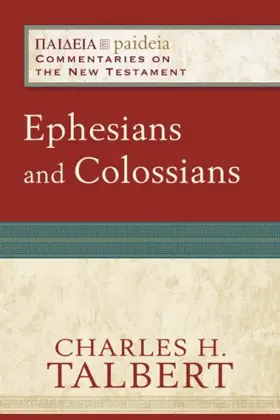

Ephesians and Colossians
in Paideia Commentaries on the New Testament
Pages
320 pages
Publisher
Baker Academic
Published
2007
ISBN-13
9780801031281
Reviews
I enjoy Talbert's emphasis on first century Graeco-Roman backgrounds as shedding light on Ephesians, though I am not sure he has fully thought through whether these are simply interesting parallels or whether they actually affect our interpretation of Ephesians. For example, he states on p. 17: "Given the pervasive theme of unity in Ephesians, the 'world' of Ephesians must have included a desire for or emphasis upon unity and the overcoming of factions."
I’m not so sure about this. 1) One could say that everyone has a desire for unity, and that it is not necessarily unique or special to the Graeco-Roman world of the first century; 2) Talbert may be begging the question. He is saying, "Look how much they talk about unity. Unity must have been a really big deal for them which is why the author wrote about unity." That is a non sequitur. Just because Paul wrote about it and examples are found in contemporary literature does not necessarily mean that that is why Paul emphasized it. We could say Paul emphasized it because it is important in God’s eyes. It also so happens that the GR world at large also saw its value. These are interesting parallels but they do not prove that that is the reason the author emphasized unity. His comment simply does not follow.
A much better use of parallels, I believe, is on pp. 79-81 where Talbert does, in my view, establish that the hostility which was destroyed was caused by the Law. The Mosaic Law led to hostility because of the way the Jews separated themselves from non-Jews.
I think his excursus on election (pp. 49-52) is very well done; however, I have to admit that I probably say this more because of the fact that I agree with his conclusions, than that he thoroughly presents arguments from both sides. Space and the format of this commentary series preclude that type of detail.
It would have been helpful, though, if he had fleshed out his thoughts in places even more. He makes sweeping statements that "Jesus' death destroyed the law of commandments in decrees, that is the Mosaic law covenant (cf. Rom 10:4; Gal 5:23-26), not just the casuistic interpretation of the law or the ceremonial, as opposed to the moral law." Whether we agree with that conclusion or not, it seems that he should have acknowledged that this is a complex issue.
Again, Talbert gives fascinating parallels on pp. 82-83, but they don’t necessarily prove that the reader would make a comparison with Caesar Augustus.
I very much appreciate the well-placed and well-chosen illustrations, including the temple warning on p. 79 and the altar to Peace on p. 83.
By design, this commentary series does not deal with detailed exegesis or critical questions (like WBC, NIGTC, etc.) so I will not run to it for these features. But I find that the attention to the overall argument and theological contribution of Ephesians is very well done. I found his treatment of "Christ's Body" (pp. 86-88) to be very well argued.
I must disagree though with his conclusion on pp. 88-94 that Judaism and Christianity were one and the same religion until the second century. I see no disparity between Romans 9-11 and Ephesians 2, contra Talbert.
I found two things irksome as I read: 1) his assumption that Paul did not write Ephesians and thus his continual comparison to the "authentic" Pauline letters; 2) his repeated statements that "ancient Mediterranean auditors would have heard this statement as..." It would have been wiser, I believe, on this second point, to say that they may have or could have heard it as such and such. In order to be more firm in these claims, he would need to give more evidence and would also need to answer the counter evidence, which he does not do. Evenhandedness requires that the other alternatives also be mentioned, though the format of the commentary may preclude full argumentation for or against all positions.
[Full Review]
Grand Rapids: Baker, 2007. Pp. xx + 296. Cloth. $24.99. ISBN 0801031281. Andrew T. Lincoln University of Gloucestershire Cheltenham, United Kingdom This volume is the first in a new series of New Testament commentaries. Its foreword makes clear that the series name, Paideia, is meant to reflect its aim: to instruct students who have theological interests in the biblical text by paying attention to the cultural, literary, and theological settings in which the text took form and to the concerns of contemporary readers. While focusing on the final form of the text, the commentaries will also emphasize the extratextual repertoire of the original readers in order to highlight the ways in which the text is designed to persuade and move such readers. Their authors will be drawn from a number of confessional perspectives—Protestant, Roman Catholic, and Greek Orthodox—and will work through the particular New Testament text in terms of its rhetorical units, exploring each in relation to (1) introductory matters, (2) the train of thought or narrative flow of the argument, and (3) theological issues raised by the text and of interest to the contemporary Christian. Charles Talbert, Distinguished Professor of Religion at Baylor University and a prolific writer, is one of the editors of the series (along with Mikeal Parsons), so his interpretation of its remit in authoring the commentary on Ephesians and Colossians is likely to provide a taster of what is to come in the rest of the series.
[Full Review]

